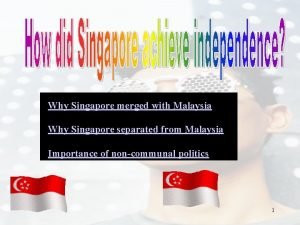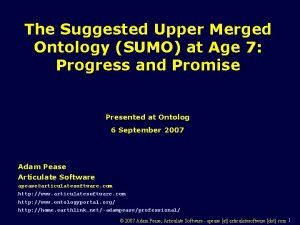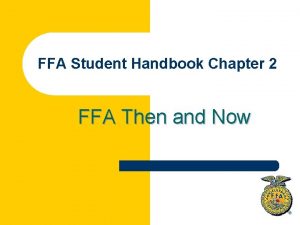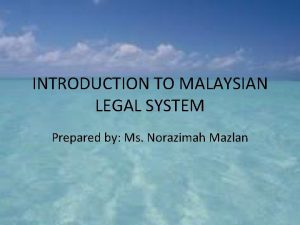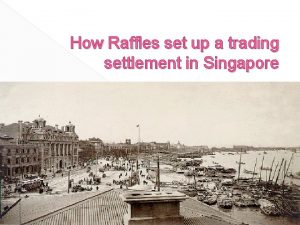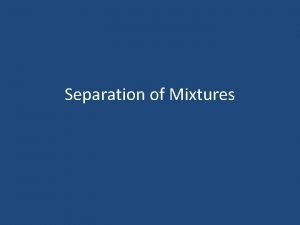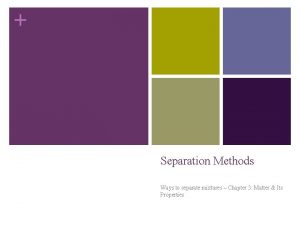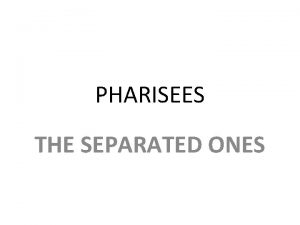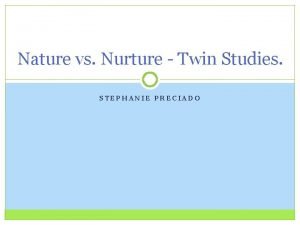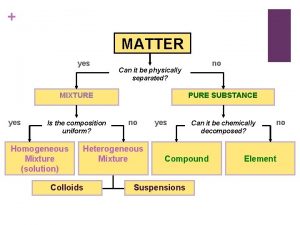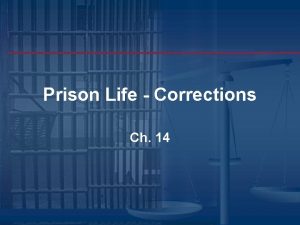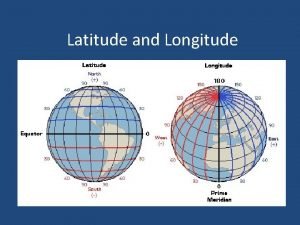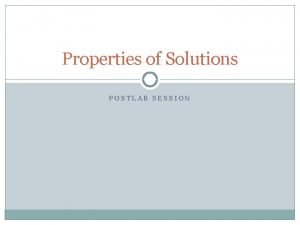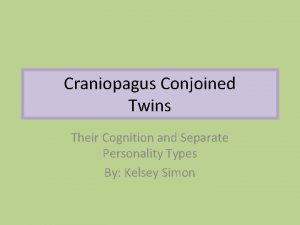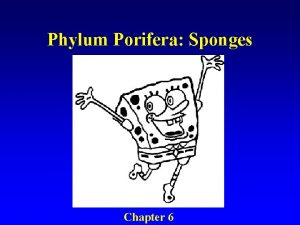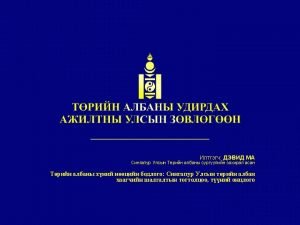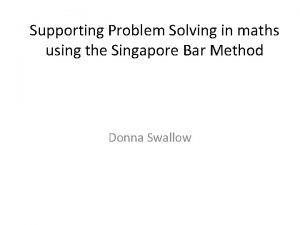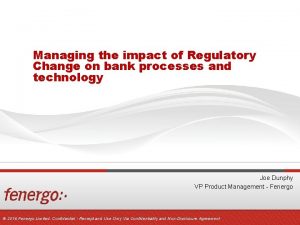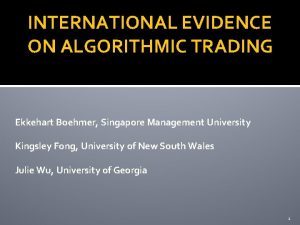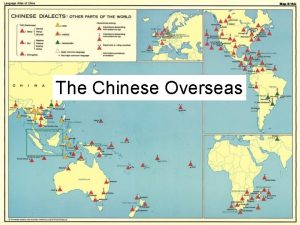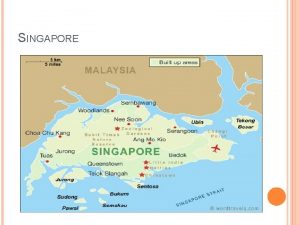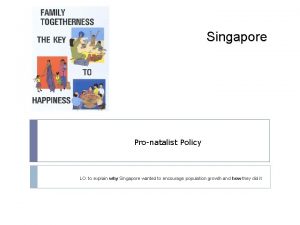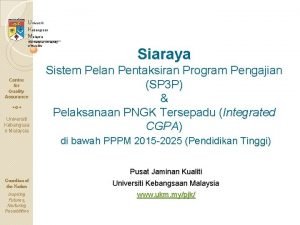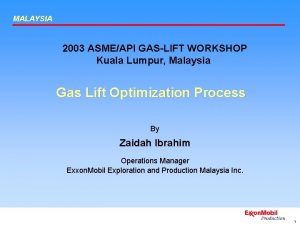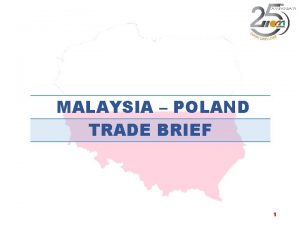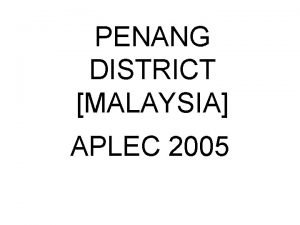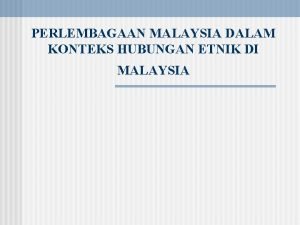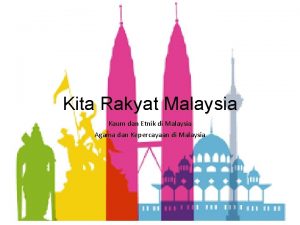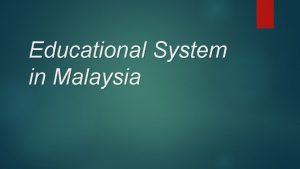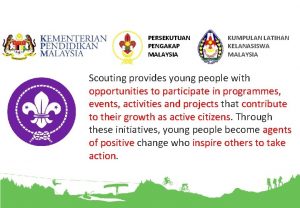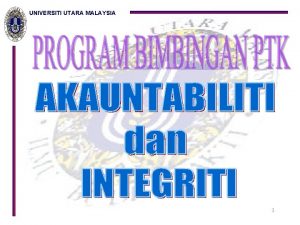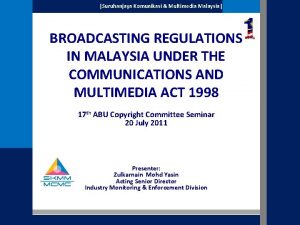Why Singapore merged with Malaysia Why Singapore separated



































- Slides: 35

Why Singapore merged with Malaysia Why Singapore separated from Malaysia Importance of non-communal politics 1

Why Singapore merged with Malaysia 2

Why Singapore wasn’t granted independence? 1. Communist Threat • influenced the Chinese by: - equal distribution of wealth - rise of China as a communist country • Workers and students in Singapore: - organised demonstrations, strikes and riots in 1950 s 3

2. Defense of British Interests • Naval Base in Singapore important: - ensured British power in the region - protected British interests like trade 3. Economy • Doubted Singapore’s ability - there are no large scale industries - there is no large scale agriculture British Decision on Singapore: • Grant self-government in 1959 4

PAP in Singapore • Won first election in 1959 • Leader, Lee Kuan Yew – 1 st PM of Singapore • Division in party: pro-communist & non-communist - many Chinese-educated Singaporeans supported Communists • Non-communal party 5

Reaction from Malays: • Saw the scheme as a threat to their traditional rights, status and positions in Malaya • Formed a political party, UMNO led by Dato Onn bin Jaafar to oppose the Malayan Union British’s answer to Malay opposition: • Replaced Malayan Union with Federation of Malaya Agreement - restored some of Sultans’ powers - made it more difficult for non-Malays to obtain citizenship 6

Communal-based political parties in Malaya: • UMNO • MCA • MIC representing the Malays representing the Chinese representing the Indians 1955 Malayan General Election: • won by Alliance Party (UMNO+MCA+MIC) • 1957 – Malaya achieved independence • UMNO leader, Tunku Abdul Rahman as 1 st PM ? 7

Singapore: - self-governed (1959) - non-communal approach Malaya: - independence (1957) - communal approach 8

Tunku’s proposal (27 May 1961) A Federation of Malaya comprising Malaya, Singapore, the Borneo territories of Sabah and Sarawak, and Brunei Reasons for Tunku’s change of mind towards merger 1. Predominant Chinese population of Singapore - put to rest by including Sabah, Sarawak and Brunei into proposed Federation of Malaysia 9

Tunku’s proposal (27 May 1961) A Federation of Malaya comprising Malaya, Singapore, the Borneo territories of Sabah and Sarawak, and Brunei Reasons for Tunku’s change of mind towards merger 2. Communist influence in Singapore - did not want Singapore to fall to the communists - feared that the communists might use Singapore as a base to conduct activities / attack Malaya - communist becoming increasingly strong in Singapore and might topple PAP as the next government 10

Tunku’s proposal (27 May 1961) A Federation of Malaya comprising Malaya, Singapore, the Borneo territories of Sabah and Sarawak, and Brunei Reasons for Tunku’s change of mind towards merger 3. Alarmed at weakening power of PAP - April 1961: lost by-election in Ong Eng Guan - July 1961: lost by-election in Anson - if PAP government fell, communist might form the next government in Singapore 11

- considered the proposal attractive - Federation would be strong and stable - would reduce fear of control by another power 12

Reaction of Singapore’s government to Tunku’s proposal Division within PAP Non-communist group: - For merger - provide raw materials - provide market for manufactured goods - lead to economic growth - lead to independence Pro-communist group: - Against merger - Malayan government was anti-communist - tried to influence trade unions and PAP branches against merger - expelled from PAP - formed new party, Barisan Socialis - PAP only 1 seat majority in Legislative Assembly by Aug 1961 13

- Conducted radio talks - Held discussions about merger - Printed booklets on benefits of merger - Exhibition on merger - Referendum on 1 Sep 1962 for Singaporeans to choose from 3 options (Singaporeans chose the PAP’s option) 14

Common Market Malay Rights Issues Discussed Borneo Loan Citizenship Constitutional Matters 15

1. Common Market • Definition: Goods could be bought and sold freely without taxes within the Federation Singapore’s stand: - For the idea of Common Market - Trade would increase with Common Market - Industries would grow and jobs created due to increase in trade Malaya’s stand: - Against the idea of Common Market - Malayan goods would face competition from Singapore - Industries and factories in Malaya would be affected 16

Singapore’s suggestion: - Establish common market before merger Malaysia’s suggestion: - Establish common market after merger Compromise reached: Malaya agreed to: -establish common market gradually Singapore agreed to: -contribute 40% instead of agreed 39% of yearly revenue to Kuala Lumpur ? Both sides: also agreed that KL would grant pioneer certs. to new industries, granting them certain privileges 17

2. The Borneo Loan 3. Definition: Money for the development 4. of Sabah and Sarawak Malaysia’s suggestion: - Singapore to contribute M$50 million as gift Singapore’s suggestion: - needed the money for its own development - willing to give loan of M$50 million Compromise reached - Singapore to loan M$150 million - loan to be repaid over 15 years - no interest for first M$100 million - 50% of labour from Singapore ? 18

3. Constitutional Matters Singapore to: - gain 15 seats in Malaysian Federal Parliament instead of the entitled 24 seats - in return, Singapore gained control over its own labour policy (to check on communist better) and education policies (as KL’s education policies were pro-Malay) 19

4. Citizenship Singapore citizens - retain Singapore citizenship - become nationals of Malaysia - cannot vote in Malaysia’s election - ensure Chinese in Singapore would not upset Malay’s control in Malaysia citizens - not allowed to vote in Singapore's election Political Parties - parties from both sides can take part in elections on both sides - candidates must be citizens of territory 20

5. Malay Rights - Special rights of Malays not extended to Malays in Singapore - Malays in Singapore recognised as indigenous inhabitants - Free education for Singapore Malays up to university - Help to improve economic and social position 21

- Signed in July 1963 in London - Malaya, Singapore, Sabah and Sarawak merged - Brunei opted out - Official proclamation: 16 September 1963 22

Reasons for Separation Political 1963 Election 1964 Election Social Programmes Economic Industrialisation Race Riots Common Market ‘Malaysian Malaysia’ Singapore’s Contribution Bank of China 23

1. The 1963 Singapore General Election • UMNO, MCA and MIC formed Singapore Alliance (SA) to take part in election • PAP refused Tunku’s proposal of PAP not competing in same constituencies as SA • Tunku personally came to Singapore to support SA § SA lost all the seats in the election • also lost 3 Malay majority areas • signal that Singapore Malays not for communal politics • Tunku promised to give more attention to SA in next election – further strained relations 24

2. The 1964 Federal Election - PAP sent 17 candidates - Alliance saw PAP as a challenge to its supremacy - Alliance unhappy over PAP’s criticism of MCA as poor representative of urban Chinese in Malaysia - In return, UMNO pledged its support for MCA - PAP only won 1 vote in Bungsar constituency ? - UMNO stepped up its criticism of PAP 25

Social Issues – The Question of Communalism 1. PAP’s programmes - Some UMNO leaders portrayed PAP’s resettlement and redevelopment programmes as anti-Malay; of the 2, 500 families affected, only 200 were Malay - anti-PAP campaign was carried out in Utusan Melayu, a Malay daily newspaper printed in Jawi scripts - PAP planned meeting with Malays on 19 July 1964 - UMNO organised a meeting on 12 July 1964 – Syed Ja’afar Albar, UMNO’s Secretary General, made a fiery speech calling for arrest of PM of Singapore ? 26

Social Issues – The Question of Communalism 2. Race Riots – differing views on the cause of riots -21 July 1964, over 20, 000 Malays and Muslims gathered to celebrate birthday of Prophet Muhammad - leaflets calling Malays to destroy PAP distributed - near Kallang, clash between a Chinese policeman and group of Malays started the riots - Singapore under curfew - 23 died and 454 injured - another riot in September 1964 (13 killed and 106 injured) ? 27

Differing views on the causes of the riots Malays felt neglected and thought that they would be better under Malaysia Started by rumours, exaggerations and lies created to arouse hatred among Malays ? 28

3. Idea of ‘Malaysian Malaysia’ - Started by Malaysian Solidarity Convention (formed by PAP to create united opposition to communal-based Alliance) - all Malaysians, regardless of race, language or religion, to be given equal opportunities - UMNO saw this as attack on Malay rights and privileges - demanded arrest of Lee Kuan Yew 29

1. Industralisation programmes in Singapore - Singapore felt that KL was reluctant to grant pioneer certificates to new industries in Singapore - 1963 to 1965: only 2 of 69 applications approved - KL however, wanted to spread new industries throughout Malaysia and not just Singapore and KL 30

2. No Common Market - KL not keen to set up Common Market, although agreed to do so - Singapore goods to Malaysia taxed highly - discouraged investors from setting up factories in Singapore – attractive financial packages to set up business in Peninsula 31

3. Singapore’s Contribution to Federal Government - Malaysian Financial Minister wanted Singapore’s contribution to increase from 40% to 60% - this was to pay for cost of dealing with the Indonesian Confrontation - Singapore refused as it would cripple Singapore’s economy 32

4. Dispute over Closing of Bank of China - KL proposed closing of Bank of China in Singapore - KL felt that funds were sent from bank to communists in northern Malaya - Singapore was not for it as the bank played an important role in Singapore-China trade; Chinese goods were affordable for Singaporeans 33

Reasons for Separation Political 1963 Election 1964 Election Social Programmes Economic Industrialisation Race Riots Common Market ‘Malaysian Malaysia’ Singapore’s Contribution Bank of China 34

- feared further racial conflicts - could not see any other way but separation - fear of communism in Singapore also resolved with ‘Operation Cold Store’ in Feb 1963 when many communist leaders were arrested 35 - 9 August 1965: announced separation ?
 Why was a merger between singapore and malaya proposed
Why was a merger between singapore and malaya proposed Suggested upper merged ontology
Suggested upper merged ontology History of floral design assessment
History of floral design assessment Ffa history timeline
Ffa history timeline What movement had the greatest influence on the renaissance
What movement had the greatest influence on the renaissance Malaysia malaysia malaysiansleereuters
Malaysia malaysia malaysiansleereuters Andreas carlsson bye bye bye
Andreas carlsson bye bye bye How raffles set up a trading settlement in singapore
How raffles set up a trading settlement in singapore Separation technique for red and blue marbles
Separation technique for red and blue marbles Decanting
Decanting Pictures of mixtures
Pictures of mixtures What is a pharisee
What is a pharisee Twins separated at birth nature vs nurture
Twins separated at birth nature vs nurture Matter can it be physically separated
Matter can it be physically separated Man separated from god
Man separated from god Dna fragments can be separated by
Dna fragments can be separated by A simple pendulum of length 40 cm subtends 60
A simple pendulum of length 40 cm subtends 60 Dna fragments can be separated by
Dna fragments can be separated by Quarter
Quarter A is an enclosed facility separated from society
A is an enclosed facility separated from society Imaginary horizontal lines
Imaginary horizontal lines Mongo seeds will dissolve in one cup of water yes or no
Mongo seeds will dissolve in one cup of water yes or no Gas particles are separated by relatively large distances
Gas particles are separated by relatively large distances What happened to tatiana and krista hogan
What happened to tatiana and krista hogan Nucleic acid food examples
Nucleic acid food examples Specimen identification
Specimen identification Roles of chanocytes
Roles of chanocytes Dont ask
Dont ask Rick griffith
Rick griffith Kailan unang umalis ng bansa si jose rizal?
Kailan unang umalis ng bansa si jose rizal? Largest employer in singapore
Largest employer in singapore Sue has 4 pieces of wood
Sue has 4 pieces of wood Singapore resuscitation and first aid council
Singapore resuscitation and first aid council Fenergo singapore fatca
Fenergo singapore fatca Charles and keith swot analysis
Charles and keith swot analysis Algorithmic trading singapore
Algorithmic trading singapore
